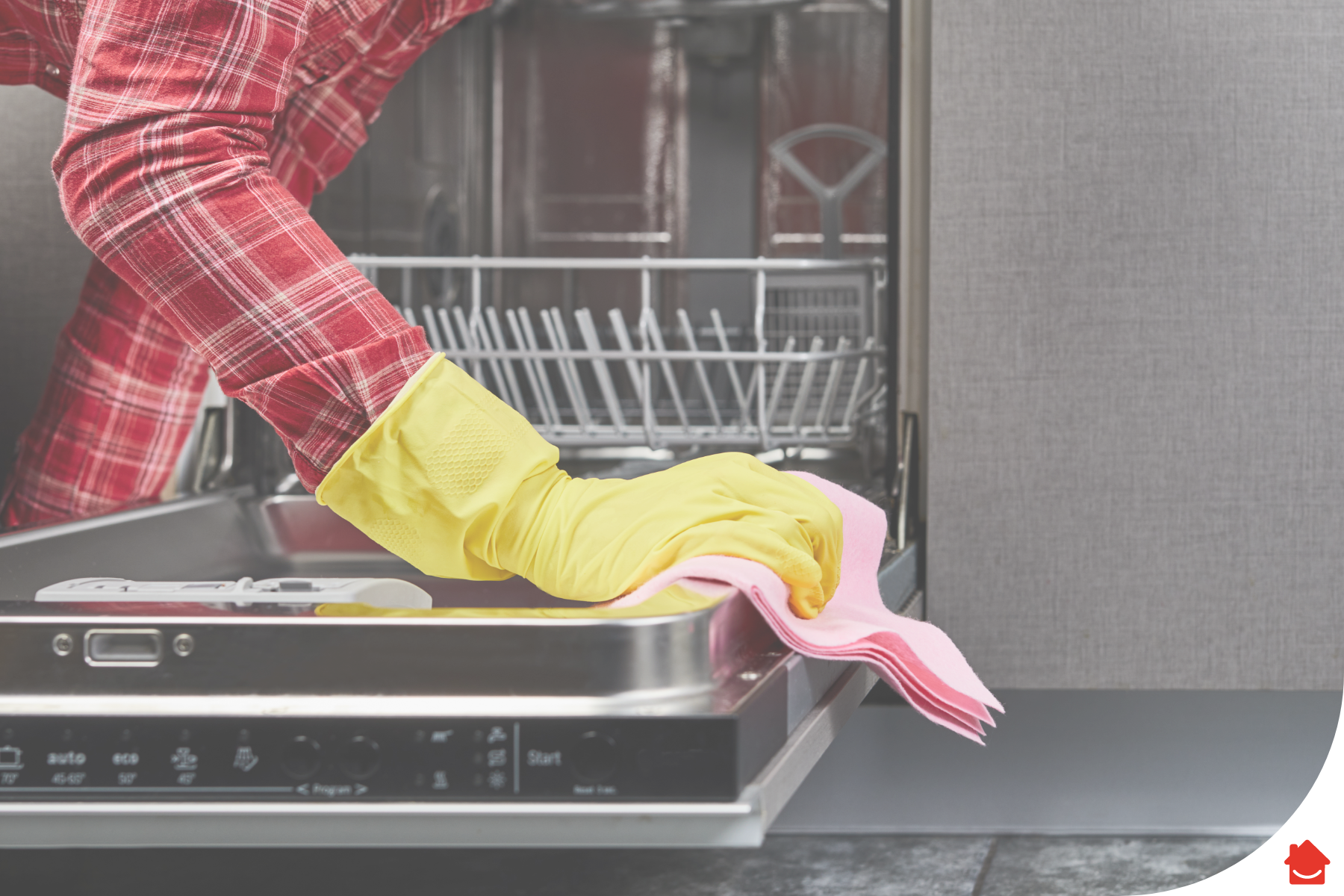Yes, the appliance that dutifully washes your dishes needs its own spring clean from time to time. Truth be told, if you establish a few key habits that you can do daily, weekly and monthly, it won’t be difficult or time-consuming to keep your dishwasher sparkling all year round. This guide will show you how to clean a dishwasher and tackle dishwasher smells with some step-by-step instructions and helpful tips.
Why does my dishwasher need cleaning?
It seems counterintuitive, doesn’t it? In theory, your dishwasher should be cleaning itself every night. It’s not, sadly.
Over time, bits of food, grease, not quite dissolved dishwasher tablets and water minerals build up on the dishwasher’s filter and insides. Not only do these deposits look bad, they eventually cause your dishwasher to stink because of a build-up of bacteria – we all know this thrives in warm, moist, dark places.
If there’s a build-up of gunk it can leave spots and film on your glassware and dishes. It can even potentially cause a blockage that will put your dishwasher out of action and/or damage your dishwasher’s filter and pump, which means you may then need to have it professionally repaired.
If you’ve got a dishwasher blockage, read our how to unblock a dishwasher article to check for and fix common causes.
We know we have to clean our kettles and coffee machines, and our kitchen worktops – so give your dishwasher a little love too and your dishes will come out clean and serene. Luckily, cleaning the dishwasher can be done quickly and easily with items you already have kicking around your cupboards: white vinegar, baking soda.
How often do I have to clean my dishwasher?
There are a few small habits you can work in, daily, weekly and monthly to keep your dishwasher in tip-top condition:
Daily
Rinse your dishes before you put them in the dishwasher!
Make sure your dishwasher isn’t acting as if it’s a waste disposal – this is the road to ruin because all of the above problems are often down to one culprit: leftover food. By rinsing your dishes before you load the dishwasher, you cut out a major factor in dishwasher unhappiness. This habit is so simple and your machine will really thank you for it!
Check for food particles after each cycle
Another helpful 1-minute habit is to remove any leftover bits of food – the odd bean or piece of pasta, for example – with a bit of kitchen roll after each dishwashing cycle. Pull out the bottom rack and make sure the filter well doesn’t have any lingering bits and bobs.
For the clean-freaks
Keep a spray bottle with white vinegar handy and spray the inside of your machine in between washes to keep it smelling and looking fresh and clean.
Weekly
Rinse the filter, racks and utensil holders
The filter is the first point of call for any bits of food and grime to build-up. Give it a 5-minute clean once a week and the more complicated parts of your machine that are deeper inside will be protected.
How do I clean my dishwasher filter?
- Take out the bottom rack
- Unscrew and remove the filter – it’s in a well at the bottom of the dishwasher
- Rinse your filter in the kitchen sink under hot running water
- Grab an old toothbrush and use it to scrub the mesh screen and plastic frame to get rid of any grease or particles stuck in the crevices. You can use a bit of washing up liquid too
- While the filter is still out of your machine, inspect the area beneath the filter inside the well. Remove any bits of debris you find to prevent it from blocking the drain. (You may be surprised at what you might find in there – glass shards, bits of plastic, bones etc.) Once these are removed give the well a scrub with your old toothbrush
- Once you’re happy it’s clean, screw it back into the bottom of your dishwasher.
Now give your dishwasher racks and utensil holder a quick spritz
- Take out the racks and utensil holders
- Wipe off any food particles or other scummy bits
- Give them a quick scrub under running water
- Replace them.
Lastly, give the door and controls a wipe
Take a damp dishcloth or sponge and wipe away any residue or spots that may have splashed or settled onto the interior surface of the door, door edges, handle, or dishwasher controls.
Now your dishwasher is good for another week of heroic, eco-friendly cleaning.
Monthly
Do a deep clean every month – you’ll need to put on the marigolds for this one.
1. Vinegar deep-clean
You can get dishwasher cleaning tablets but we prefer to do it the DIY way because it uses fewer chemicals.
White vinegar is astringently acidic. These properties mean it can easily break down food particles and grime.
- Fill a small bowl with two cups of white vinegar
- Place it on the upper rack of your otherwise empty dishwasher
- Run a hot cycle without any dishwasher detergent or dishes.
2. Baking soda deep-clean
Baking soda is a safe, alkaline substance that can also help to get rid of bad smells and grime.
- Sprinkle one small cup of baking soda along the bottom of your dishwasher and rinse on an empty hot water cycle
- If you have especially stubborn stains or smells, repeat.
3. Hydrogen peroxide dishwasher bombs
(This is like making bath bombs for your dishwasher!)
- Grab a bowl
- Mix 2 small cups of baking soda with three tablespoons of hydrogen peroxide into a paste
- Drop spoonfuls of it onto baking paper and allow it to dry for a few hours.
- Put your dishwasher bath bombs on the bottom of your dishwasher and run a hot-water cycle in an empty machine
- For a fresher fragrance, add a few drops of essential oil.
Handy dishwasher cleaning tips:
- If you have a waste disposal, clear it out before starting a load of dishes. Dishwashers usually drain into the same drainpipe as your sink, so keeping it clear will prevent any build-up
- Make sure your nightly dishwasher cycle starts with hot water by running your kitchen tap until it gets hot. This way your dishwasher will start cleaning with hot water straight away
- Make sure your water is at the right temperature. Your boiler or hot water heater should be set to about 50°C. Cooler water won’t clean properly, and if it’s too hot the water could scald someone
- Don’t overfill your dishwasher. Yes, only running full loads of dishes helps to conserve water and energy, but regularly overfilling could cause a strain on your dishwasher and means your dishes don’t clean properly, so you’ll have to put them on another cycle.
Cleaning your dishwasher if you live in a hard water area
If you have hard water in your area (check your postcode here) your dishwasher may accumulate hard water deposits or mineral build-up. Lemon juice can really help here because the acid works to remove hard water spots.
- Place a cup of lemon juice in the top rack of your dishwasher
- Run a normal cycle.
Do you need further help?
If you come up against any dishwasher problems that can’t be solved by cleaning or unblocking your dishwasher, it may be time to call in a professional.
FAQs
What is the best way to clean the inside of a dishwasher?
Remove particles of food after each cycle and use white vinegar and baking soda to do a monthly deep clean during an empty cycle.
How do you clean a dishwasher with vinegar and baking soda?
- Fill a cereal bowl with two cups of white vinegar, place it on the upper rack of an empty dishwasher and run a hot cycle
- Sprinkle baking soda along the bottom of your dishwasher and rinse on an empty hot water cycle.
What is the best dishwasher cleaner?
White vinegar and baking soda are effective, non-abrasive dishwasher cleaners.
Is vinegar bad for dishwashers?
White vinegar is astringently acidic, which means it’s one of the best natural cleaning products for the inside of your dishwasher because it breaks down grime while being non-abrasive and non-harmful for the environment.




